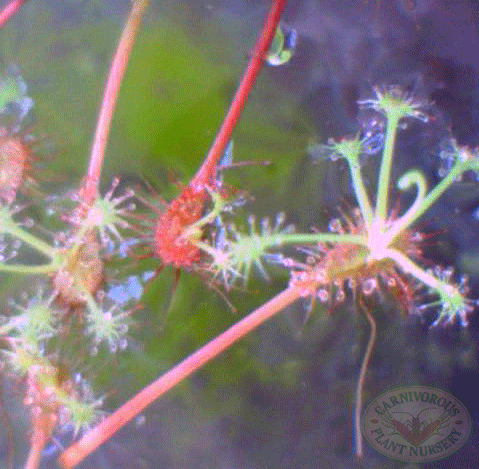
Propagation
Carnivorous Plants are generally easy to propagate. Their natural habitat, the bog, is one that can be disruptive to growing plants. Spring floods in the low wetlands often break up plants and wash them down stream. Carnivorous plants have adapted to reproducing vegetatively in order to spread and survive this stress. This features means that leaf and root cuttings can work very successfully with most carnivorous plants, especially the sundews and pitcher plants.
Methods of Propagation include:
Seeds
False Vivipary
Natural Leaf Budding
Stolons
Rhizome Budding
Rhizome Cuttings
Leaf Cuttings
Rhizome Divisions
Decapitation
Tissue Culture
Seeds
Generally speaking, the seeds of Carnivorous Plants are quite small and very slow growing. It takes a typical pitcher plant 3 to 4 years to gain a height of over 2 inches. Because of this, most Carnivorous Plants generally are not practical for classroom germination and growth. There is one nice exception: the sundews. These can germinate within a few days or weeks, grow quickly and even flower within a few months.
The best medium for seedlings is finely chopped, live green Sphagnum mixed with an equal amount of clean, washed sand. Mix and water thoroughly. The medium should be soaking wet. Sow the seeds directly on the surface. Do not overcrowd them and do not cover any Carnivorous Plant seeds with medium. Cover the growing area with plastic to keep humidity extra high. Place the seeded pots in the same growing conditions that the mature plants require. Use slightly filtered, rather than direct sunlight.
As a general rule, seeds that mature in the spring are ready for immediate sowing. Seeds that ripen in the fall must undergo a period of damp cold treatment called stratification. This can be accomplished by placing the seed-sown pot upright in a sealed plastic bag and refrigerating it for 6 to 8 weeks.
False Vivipary
False vivipary is the growth of a plantlet at the flower spike. This can occur with the Venus Flytrap and sundews. When the plantlet develops roots it can be removed carefully and placed in a Carnivorous Plant soil mixture.
Natural Leaf Budding
Some Carnivorous Plants will develop small plants along the leaf margin. This is fairly common with the butterworts and sundews. When the buds are large enough and have developed roots of their own, they can be separated and planted in a Carnivorous Plant soil mixture.
Stolons
Some Carnivorous Plants, such as the Cobra Lily, will develop plantlets along stolons or runners. These can be cut loose and replanted after they develop their own roots.
Rhizome Budding
Many of the pitcher plants and some other Carnivorous Plants will naturally develop small plants along the rhizome branch. These can successfully be separated by cutting them after they develop their own roots. Plant them in a Carnivorous Plant soil mixture.
Rhizome Cuttings
Pitcher plants can easily be propagated using rhizome cuttings. Use a large mature rhizome. Completely uncover the upper half of a horizontal rhizome of a healthy mature plant. Leave the lower rooted section intact. With a sharp, fresh, single-edged razor blade, carefully slice perpendicularly into the rhizome about halfway. Repeat this at several points about 1 inch apart. Leave the top of the rhizome uncovered, and in a few weeks new growth buds will appear at the cuts. When they develop their own roots they may be separated and planted in a Carnivorous Plant soil mixture.
Leaf Cuttings
Leaf cuttings work very well with sundews, moderately well with butterworts and fairly well with Venus Flytraps. This is best done in the early growing season of Spring. Cut off a fresh, healthy, mature leaf at the base of the petiole with a clean, fresh, single-edged razor blade. Place the entire leaf right-side-up on a bed of moist, finely chopped green Sphagnum. The lower side of the leaf must lie flat on the Sphagnum. You can do this by placing a single layer of cheesecloth over the leaf or by pinning it down with toothpicks. Place your pot of leaf cuttings in the shade into a plastic bag or other high humidity area. Choose a warm, but not hot place. Plantlets will occur in several weeks. Let them develop their own root systems before separating them and planting them in a Carnivorous Plant soil mixture. Slowly acclimate the new plants to their normal growing conditions. Leaf cuttings also can be placed in water to develop plantlets. This is especially useful with the sundews.
Rhizome Division
Rhizomes of many Carnivorous Plants can simply be cut into 1 inch sections and planted separately. If roots are included in the sections, take care not to damage them. This works very well with pitcher plants.
Decapitation
Many sundews can be propagated asexually by decapitation. Simply cut off the plant at, or just below, the soil level. Place the cut off top firmly into Carnivorous Plant soil. The top will regenerate roots and the root section of the original plant will regenerate another plant.
Tissue Culture
Carnivorous Plants can be rapidly propagated using tissue culture. The resulting plants are identical to the parent plant. This is a rather involved process and too lengthy for discussion here. Find appropriate directions and materials, and you should have good success.
